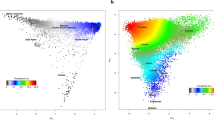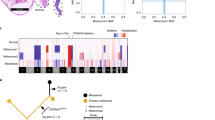Abstract
Objective
To assess the association of skin color using Fitzpatrick Skin Type (FST) with metastatic risk of uveal melanoma.
Subjects
854 consecutive patients with uveal melanoma and documented FST.
Methods
Retrospective detailed review of patient charts was performed for FST (type I- white, II-fair, III-average, IV-light brown, V-brown, VI-black), clinical details of the patient and the uveal melanoma, tumor cytogenetic classification according to The Cancer Genome Atlas (TCGA), and outcome of melanoma-related metastasis and death.
Results
The FST classification was type I (n = 97 patients), type II (n = 665), type III (n = 79), type IV (n = 11), type V (n = 2), type VI (n = 0). A comparison of patient FST (type I vs. II vs. III-V) revealed significant differences in mean age at presentation (64.1 vs. 58.5 vs. 49.8 years, p < 0.001), race white (100% vs. 98% vs. 75%, p < 0.001), presence of ocular melanocytosis (3% vs. 3% vs. 10%, p = 0.01), visual acuity <20/200 at presentation (6% vs. 7% vs. 13%, p = 0.03), genetic results showing TCGA group B tumors (11% vs. 14% vs. 26%, p = 0.01) or TCGA group D tumors (22% vs. 11% vs. 9%, p = 0.01), 10-year incidence of melanoma-related metastasis (25% vs. 15% vs. 14%, p = 0.02) and 10-year incidence of melanoma-related death (9% vs. 3% vs. 4%, p = 0.04). FST was a significant predictor of melanoma-related metastasis (p = 0.02, Hazard ratio 2.3).
Conclusions
Fitzpatrick skin type may be a predictor of melanoma-related metastasis, with metastasis and TCGA Group D tumors being more common in patients with FST I.
This is a preview of subscription content, access via your institution
Access options
Subscribe to this journal
Receive 18 print issues and online access
$259.00 per year
only $14.39 per issue
Buy this article
- Purchase on Springer Link
- Instant access to full article PDF
Prices may be subject to local taxes which are calculated during checkout

Similar content being viewed by others
Data availability
The raw data for the study are not publicly available to preserve individuals’ privacy under the Health Insurance Portability and Accountability Act (HIPPA) and European General Data Protection Regulation. CLS, M.D. has had full access to all the data in the study and takes responsibility for the integrity of the data.
References
Fitzpatrick TB. Soleil et peau [Sun and skin]. J de Médecine Esthétique. 1975;2:33–4.
Fitzpatrick TB. The validity and practicality of sun-reactive skin types I through VI. Arch Dermatol. 1988;124:869–71.
Mercieca L, Aquilina S, Calleja N, Boffa MJ. Cutaneous Melanoma More Likely to Be Invasive in Fairer Skin Phototypes: A Retrospective Observational Study. Skinmed 2021;19:280–3.
Kulichová D, Dáňová J, Kunte C, Ruzicka T, Celko AM. Risk factors for malignant melanoma and preventive methods. Cutis 2014;94:241–8.
Elwood JM, Gallagher RP, Hill GB, Spinelli JJ, Pearson JC, Threlfall W. Pigmentation and skin reaction to sun as risk factors for cutaneous melanoma: Western Canada Melanoma Study. Br Med J. 1984;288:99–102.
Sitek A, Rosset I, Żądzińska E, Kasielska-Trojan A, Neskoromna-Jędrzejczak A, Antoszewski B. Skin color parameters and Fitzpatrick phototypes in estimating the risk of skin cancer: A case-control study in the Polish population. J Am Acad Dermatol. 2016;74:716–23.
Beral V, Evans S, Shaw H, Milton G. Cutaneous factors related to the risk of malignant melanoma. Br J Dermatol. 1983;109:165–72.
Lock-Andersen J, Drzewiecki KT, Wulf HC. Eye and hair colour, skin type and constitutive skin pigmentation as risk factors for basal cell carcinoma and cutaneous malignant melanoma. A Danish case-control study. Acta Derm Venereol. 1999;79:74–80.
Gogia R, Binstock M, Hirose R, Boscardin WJ, Chren MM, Arron ST. Fitzpatrick skin phototype is an independent predictor of squamous cell carcinoma risk after solid organ transplantation. J Am Acad Dermatol. 2013;68:585–91.
Lam M, Zhu JW, Hu A, Beecker J. Racial Differences in the Prognosis and Survival of Cutaneous Melanoma From 1990 to 2020 in North America: A Systematic Review and Meta-Analysis. J Cutan Med Surg. 2022;26:181–8.
Harvey VM, Patel H, Sandhu S, Wallington SF, Hinds G. Social determinants of racial and ethnic disparities in cutaneous melanoma outcomes. Cancer Control. 2014;21:343–9.
Cormier JN, Xing Y, Ding M, Lee JE, Mansfield PF, Gershenwald JE, et al. Ethnic differences among patients with cutaneous melanoma. Arch Intern Med. 2006;166:1907–14.
Hu S, Parmet Y, Allen G, Parker DF, Ma F, Rouhani P, et al. Disparity in melanoma: a trend analysis of melanoma incidence and stage at diagnosis among whites, Hispanics, and blacks in Florida. Arch Dermatol. 2009;145:1369–74.
Clairwood M, Ricketts J, Grant-Kels J, Gonsalves L. Melanoma in skin of color in Connecticut: an analysis of melanoma incidence and stage at diagnosis in non-Hispanic blacks, non-Hispanic whites, and Hispanics. Int J Dermatol. 2014;53:425–33.
Wu XC, Eide MJ, King J, Saraiya M, Huang Y, Wiggins C, et al. Racial and ethnic variations in incidence and survival of cutaneous melanoma in the United States, 1999-2006. J Am Acad Dermatol 2011;65:S26–37.
Collins KK, Fields RC, Baptiste D, Liu Y, Moley J, Jeffe DB. Racial differences in survival after surgical treatment for melanoma. Ann Surg Oncol. 2011;18:2925–36.
Broly M, Drak Alsibai K, Cenciu B, Guevara H, Fayette J, Neidhardt EM, et al. Clinical and histological characteristics, and management of melanoma in French Guiana, 2007-18. Int J Dermatol. 2020;59:997–9.
Shields CL, Yaghy A, Dalvin LA, Vaidya S, Pacheco RR, Perez AL, et al. Conjunctival Melanoma: Features and Outcomes Based on the Fitzpatrick Skin Type in 540 Patients at a Single Ocular Oncology Center. Ophthalmic Plast Reconstr Surg. 2020;36:490–6.
Houtzagers LE, Wierenga APA, Ruys AAM, Luyten GPM, Jager MJ. Iris Colour and the Risk of Developing Uveal Melanoma. Int J Mol Sci. 2020;21:7172.
Weis E, Shah CP, Lajous M, Shields JA, Shields CL. The Association Between Host Susceptibility Factors and Uveal Melanoma: A Meta-analysis. Arch Ophthalmol. 2006;124:54–60.
Gallagher RP, Elwood JM, Rootman J, et al. Risk factors for ocular melanoma: Western Canada Melanoma Study. J Natl Cancer Inst. 1985;74:775–8.
Egan KM, Seddon JM, Glynn RJ, et al. Epidemiologic aspects of uveal melanoma. Surv Ophthalmol. 1998;32:239–51.
Hu DN, Yu GP, McCormick SA, Schneider S, Finger PT. Population-based incidence of uveal melanoma in various races and ethnic groups. Am J Ophthalmol. 2005;140:612–7.
Xu Y, Lou L, Wang Y, Miao Q, Jin K, Chen M, et al. Epidemiological Study of Uveal Melanoma from US Surveillance, Epidemiology, and End Results Program (2010-5). J Ophthalmol. 2020;19:3614039.
Vajdic CM, Kricker A, Giblin M, et al. Eye color and cutaneous nevi predict risk of ocular 528 melanoma in Australia. Int J Cancer. 2001;92:906–12.
Gelmi MC, Bas Z, Malkani K, Ganguly A, Shields CL, Jager MJ. Adding the Cancer Genome Atlas Chromosome Classes to American Joint Committee on Cancer System Offers More Precise Prognostication in Uveal Melanoma. Ophthalmology 2022;129:431–7.
Shields CL, Mayro EL, Bas Z, et al. Ten-year outcomes of uveal melanoma based on the cancer genome atlas (TCGA) classification in 1001 cases. Indian J Ophthalmol. 2021;69:1839.
Ewens KG, Kanetsky PA, Richards-Yutz J, et al. Genomic profile of 320 uveal melanoma cases: chromosome 8p-loss and metastatic outcome. Investig Ophthalmol Vis Sci. 2013;54:5721–9.
Vichitvejpaisal P, Dalvin LA, Mazloumi M, Ewens KG, Ganguly A, Shields CL. Genetic analysis of uveal melanoma in 658 patients using the cancer genome atlas classification of uveal melanoma as A, B, C, and D. Ophthalmology 2019;126:1445–53.
Wierenga APA, Brouwer NJ, Gelmi MC, et al. Chromosome 3 and 8q aberrations in uveal melanoma show greater impact on survival in patients with light iris versus dark iris color. Ophthalmology. 2022;129:421–30.
Phillpotts BA, Sanders RJ, Shields JA, Griffiths JD, Augsburger JA, Shields CL. Uveal melanomas in black patients: a case series and comparative review. J Natl Med Assoc. 1995;87:709–14.
Rajeshuni N, Zubair T, Ludwig CA, Moshfeghi DM, Mruthyunjaya P. Evaluation of Racial, Ethnic, and Socioeconomic Associations With Treatment and Survival in Uveal Melanoma, 2004-14. JAMA Ophthalmol. 2020;138:876–84.
Shields CL, Kaliki S, Cohen MN, Shields PW, Furuta M, Shields JA. Prognosis of uveal melanoma based on race in 8100 patients: The 2015 Doyne Lecture. Eye. 2015;29:1027–35.
Manchegowda P, Singh AD, Shields C, Kaliki S, Shah P, Gopal L, et al. Uveal Melanoma in Asians: A Review. Ocul Oncol Pathol. 2021;7:159–67.
Shields CL, Dalvin LA, Vichitvejpaisal P, Mazloumi M, Ganguly A, Shields JA. Prognostication of uveal melanoma is simple and highly predictive using The Cancer Genome Atlas (TCGA) classification: A review. Indian J Ophthalmol. 2019;67:1959–63.
Kaplan JB, Bennett T. Use of Race and Ethnicity in Biomedical Publication. JAMA 2003;289:2709–16.
LaVeist TA. Beyond dummy variables and sample selection: what health services researchers ought to know about race as a variable. Health Serv Res. 1994;29:1–16.
Tuomaala S, Eskelin S, Tarkkanen A, Kivelä T. Population-based assessment of clinical characteristics predicting outcome of conjunctival melanoma in whites. Investig Ophthalmol Vis Sci. 2002;43:3399–408.
Yu GP, Hu DN, McCormick S, Finger PT. Conjunctival melanoma: is it increasing in the United States? Am J Ophthalmol. 2003;135:800–6.
Kliman GH, Augsburger JJ, Shields JA. Association between iris color and iris melanocytic lesions. Am J Ophthalmol. 1985;100:547–8.
Funding
Support provided in part by the Eye Tumor Research Foundation, Philadelphia, PA (CLS). The funders had no role in the design and conduct of the study, in the collection, analysis and interpretation of the data, and in the preparation, review or approval of the manuscript.
Author information
Authors and Affiliations
Corresponding author
Ethics declarations
Competing interests
The authors declare no competing interests.
Additional information
Publisher’s note Springer Nature remains neutral with regard to jurisdictional claims in published maps and institutional affiliations.
Rights and permissions
Springer Nature or its licensor (e.g. a society or other partner) holds exclusive rights to this article under a publishing agreement with the author(s) or other rightsholder(s); author self-archiving of the accepted manuscript version of this article is solely governed by the terms of such publishing agreement and applicable law.
About this article
Cite this article
Negretti, G.S., Bayasi, F., Goldstein, S. et al. Association of Fitzpatrick Skin Type with metastatic risk from uveal melanoma in 854 consecutive patients at a single center. Eye 38, 565–571 (2024). https://doi.org/10.1038/s41433-023-02735-1
Received:
Revised:
Accepted:
Published:
Issue Date:
DOI: https://doi.org/10.1038/s41433-023-02735-1



